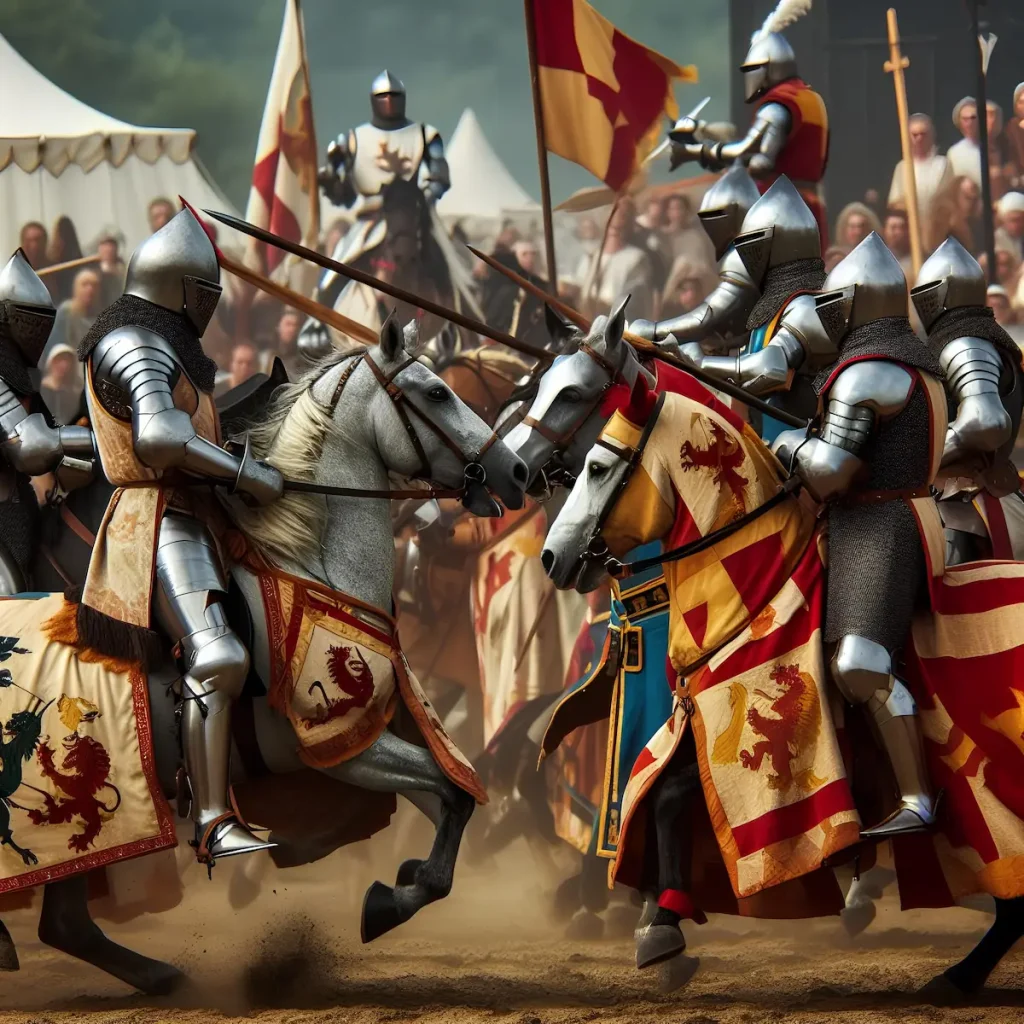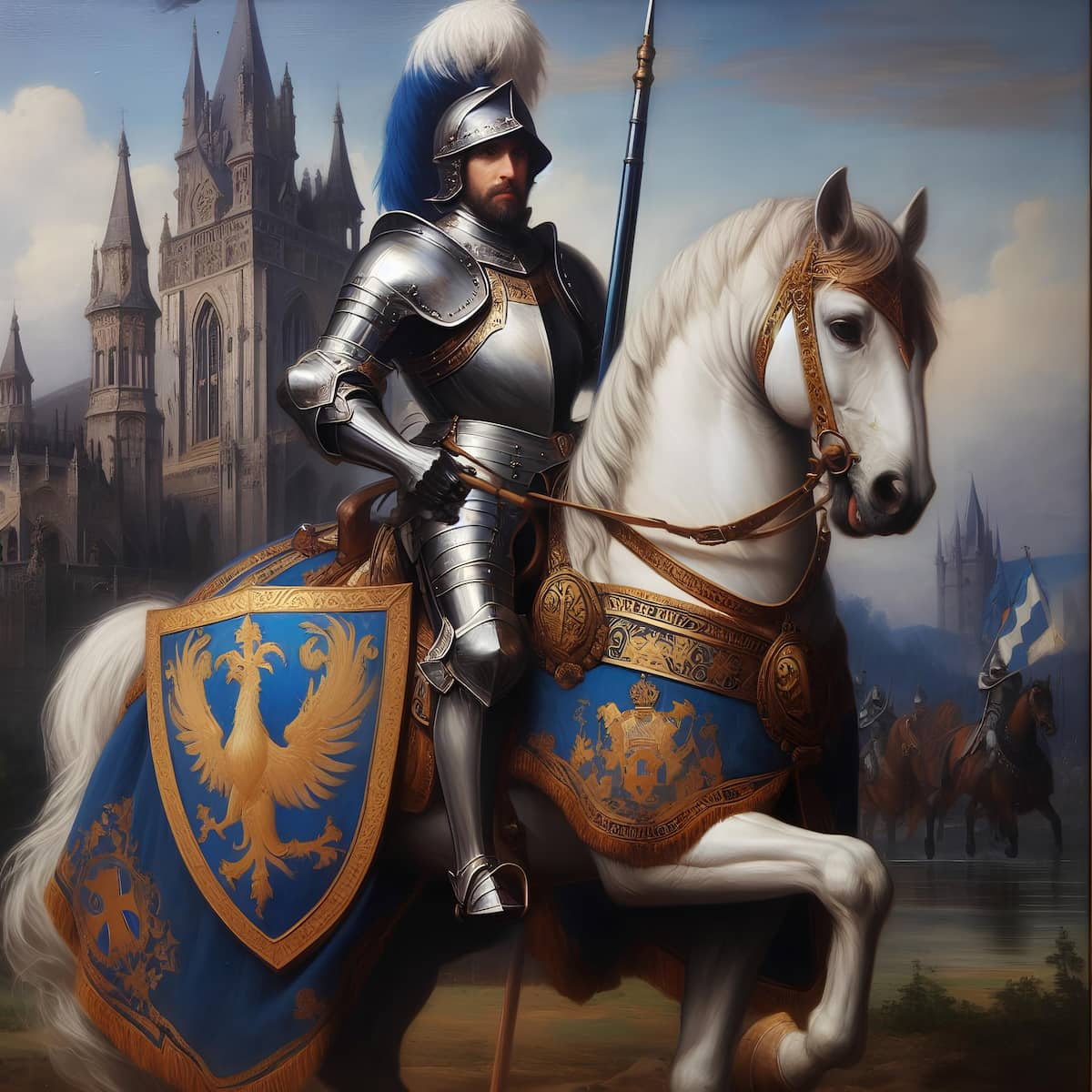Gradually organized into tournaments, jousting was a medieval combat of men on horseback who fought using a lance. Tournaments, a preferred pastime of nobles in the Middle Ages, experienced an extraordinary boom in France in the 12th century before spreading to Germany and England. Originally war games and sometimes deadly, they evolved into spectacles. They were ritualized simulations of violent combat between two teams in open fields and later jousts pitting knights against each other in pairs during chivalrous festivities, given in the 14th century “in honor of the ladies” during ceremonies, princely weddings, and other receptions…
Jousting and Knightly Weaponry
The nobles enjoy distinguishing themselves with weapons in hand, engaging in daily training from a young age. As a formative exercise for jousting, ring tilting sees skillful knights aiming for a ring fixed to a post. Lords also endorse games like shooting at the papegaut or wrestling, which serve as interludes in martial festivities. For “the safety and defense of the kingdom,” a decree by King Charles V in 1369 prohibited dice and other games in favor of archery and crossbow exercises, more suitable due to their military nature.
Learning warfare while having fun is what young boys of the aristocracy do as they practice behourd (mounted combat) and the handling of wooden swords. Castle courtyards serve as schools where young athletes are trained to acquire flexibility, agility, and strength. They engage in running, stone or javelin throwing, high jumps, either armed or unarmed, and fencing (stick or sword fighting), robust pastimes preparing them for military art.
The Quintain, a challenging trial, is a wooden articulated dummy placed atop a pole called an “estache.” Galloping towards it, the jouster must deliver a forceful lance blow against the target equipped with a hauberk and a shield to knock it down, aiming squarely in the middle. If the jouster fails to strike squarely or break his lance, he risks being unseated, thereby ridiculing himself in front of the assembly.
While nobles handle swords, lances, and maces, bourgeois and peasants practice with sticks or fists and shoot with bows or crossbows. Skill in archery is paramount in the case of a siege. The papegaut (parrot) is a bird painted green placed atop a pole or on a rampart to serve as a target. Papegaut brotherhoods gather the best shooters and distribute prizes. A formidable weapon in the hands of the Bretons, the ferruled stick, or “estoc,” already features in a poem by the troubadour Marcabrun in the 12th century.
Tournaments and Simulated Battles

Practiced regularly on St. John’s Day, at Pentecost, or on major occasions (royal weddings, plenary courts), the games of arms took place in the 12th and 13th centuries on a vast exercise field involving two armed groups with their leaders and soldiers. During these pitched battles, they clashed with real weapons, such as swords, lances, and maces, in teams from province to province. Horses and riders lined up in two lines for the maneuver to be executed.
The troops charged with a great noise of weapons and swords at the signal from trumpets or the tournament bell. Sometimes the jousters put so much zeal into the confrontation that they forgot about the sporting dimension, and fighters lost their lives. The Duke of Brittany, Geoffroy Plantagenet, died at the age of twenty-eight from a wound received at a tournament held in his honor in 1186!
This expression summarizes mixed tournaments where the stake is not only sporting: prisoners are taken (whose ransom is dearly paid), and the richly adorned horses, as well as the weapons of the vanquished, belong to the victor, representing a highly profitable trade that gives rise to controversies on the field. Some unscrupulous knights take advantage of the confusion to enrich themselves. Many barons and lords have been ruined to parade at these martial feasts! That is why the Council of Clermont condemned these detestable and mercantile games in 1130.
Tournament Shows in the 14th and 15th Centuries
The troubadour Jacques Bretel evokes in his writings, “The Tournaments of Chauvency,” the evolution of chivalrous society. The battles fought with bridles pulled tight in open fields transformed into an “elegant” sport practiced in enclosed spaces under the stands of spectators, the “hourds.
” These stands, magnificently decorated with tapestries, coats of arms, banners, and pennants, welcomed princes, ladies, and maidens adorned in their finest attire.
The fighters, heralds, and squires made a solemn entrance with their emblems and extravagant helmets of exaggerated dimensions. The crest, a kind of plume topping the helmet, was adorned with various motifs: heraldic animals, horns, branches, peacock or ostrich feathers, and embellished with a banner, the “lambrequin,” fluttering in the wind. The knights displayed vivid colors—red, green, or blue—on their shields, banners, or horse covers. They didn’t joust to enrich themselves but to showcase their skill and status with all the necessary panache. The staging resembled that of courtly romances cherished by the nostalgic nobility.
The day before the tournament, the swords, banners, and helmets were reviewed, recalling the chivalrous laws (see Chivalry in the Middle Ages). On the scheduled day, the knights appeared, their squires following them and their minstrels playing trumpets in front of them. The heraldic banners of the challengers were brought and planted on the lists. Up until the trumpets signaled the retreat, the two teams fought. The queen of the competition, her ladies-in-waiting, the herald, and the judges presented the winners with their prizes.
Jousting for the Ladies’ Love
The desire to please ladies is not foreign to the staging of tournaments. Already in the time of the troubadours, knights engaged in the games of courtly love. The champions would whirl around in the hope of seducing a beautiful heiress. The sporting encounter becomes a place of seduction. According to the chronicler Jean d’Authon, the ladies were so adorned at a tournament held in 1507 in Milan in the presence of King Louis XII that “it was like a fairy tale.”
The erotic element is evident in the custom of ladies offering their favors to their preferred knight. This could be a scarf, a veil, a sleeve (some dresses were equipped with sleeves sewn in a way to detach for this purpose), or another adornment that the chosen one adorns the top of his helmet, shield, or coat of arms with. In the frenzy of combat, the ladies offer so many adornments to the knights that in the end they find themselves bare-headed with their sleeveless coat, without a shirt or surcoat, and laugh at their adventure, “not having noticed their undressing!
“
Knights’ Weapons and Armor
Very regulated, tournaments require specific equipment quite different from that of war, necessitating the wearing of a light breastplate under which lies a padded corset of canvas and tow to cushion the blows of mace and sword. The tournament helm is gridded with large lozenges on the front for breathing and visibility.
For jousting and single combat, armorers reinforce the helm by eliminating the wide openings and replacing them with a narrow slit at eye level. This helm, named “toad’s head” because of its shape (weighing up to 9 kg), is attached to a steel corselet by huge hinges. The jouster’s armor is of considerable weight to give more power to the lance blow and stability to the rider. The breastplate is reinforced on the left side by a gauntlet on the forearm and a steel plate protecting the shoulder. Attached by a strap to the armor, the shield or targe is a wooden shield covered with leather or a deer horn with a relief grid that allows you to dodge lance blows.
The so-called courteous lance, equipped with a rochet (a point with three rounded ends to distribute the impact and avoid piercing the armor), is light and fragile enough to break easily on the opponent’s helm or shield. The rider must brace himself on his mount to not “wobble in the saddle.” It takes a lot of dexterity to direct the blow. Following this combat, there is a foot joust “at the barrier” and a clash with an axe or war mace.
Henry II’s Fatal Joust
In June 1559, splendid chivalrous festivities were held on the occasion of the marriages of Marguerite, the king’s sister, to the Duke of Savoy and Elisabeth of France to Philip II of Spain. The jousts were set up in the Saint-Antoine district, in front of the royal residence of the Tournelles.
On the 30th, after participating in several jousts, the king, wearing the colors of his mistress Diane de Poitiers, decides (despite the queen’s astrologer’s predictions) to engage in one last rematch joust against the Count of Montgomery, who had “unseated” him. Unfortunately, the opponent’s lance breaks and pierces the king’s visor, passing through his eye from one side to the other. The king will agonize for ten days in great suffering.
The tragic death of Henry II will hasten the decline of these highly prized games of the nobility.


